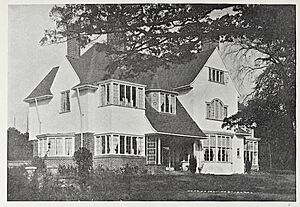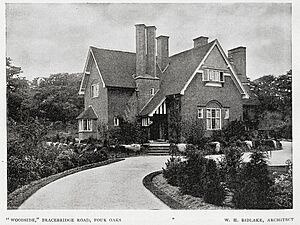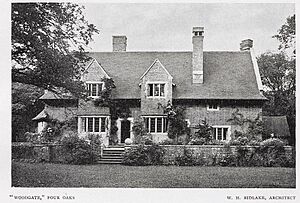Four Oaks, Sutton Coldfield facts for kids
Four Oaks is a fancy residential area in Sutton Coldfield, West Midlands. It sits right next to the north and east sides of Sutton Park. Four Oaks is about 7.5 miles (12 km) north of Birmingham City Centre. It shares borders with Sutton Park, Streetly, Mere Green, Little Aston, Roughley, and Aldridge. In 2004, Four Oaks had about 21,690 people living there. It is part of the Sutton Four Oaks electoral area.
Contents
The Four Oaks Estate
The story of the Four Oaks Estate began in 1677. A man named Henry Folliott, 3rd Baron Folliott of Ballyshannon bought 60 acres (24 hectares) of woodland. He then built a large house called Four Oaks Hall. Folliott passed away in 1716, but his wife lived in the Hall until 1751.
Later, the estate was sold to Simon Luttrell, 1st Earl of Carhampton. He updated the house and made it more modern. In 1757, he bought another 50 acres (20 hectares) of woodland. This was to make his estate bigger and create a deer park. Over the years, the estate changed hands several times. In 1827, another owner, Sir Edmund Cradock-Hartopp, 1st Baronet, bought 35 more acres (14 hectares) to expand the deer park even further.
In 1868, the estate was sold to Hubert de Burgh-Canning, 2nd Marquess of Clanricarde. He planned to build many homes there. Roads were named to remember the estate's history. Between 1895 and 1915, about 200 houses were built, creating what is now known as the Four Oaks Estate. The old Four Oaks Hall was in bad shape and was taken down in 1898. Carhampton House now stands where it used to be.
Today, the Four Oaks Estate is mostly a place where people live. The Four Oaks Tennis Club is right in the middle of it. The estate is roughly surrounded by Lichfield Road, Four Oaks Road, Sutton Park, and the Sutton Park Line railway. It is known as one of the most expensive places to live in the West Midlands. Many wealthy people live on the roads within the Park.
The Four Oaks Park area has many large houses and roads lined with trees. These roads often have speed bumps to keep traffic slow. Famous architects like Charles Bateman designed the houses on the Estate. Many of these homes sell for at least £2 million. Some houses are even "listed buildings," which means they are protected because of their special history or architecture. The Four Oaks Tennis Club, a popular local spot, was started in 1906.
The roads on the Four Oaks Estate are looked after by a company called Four Oaks Estate Ltd. A group of directors, who all live on the Estate, manage this company.
In 2019, Four Oaks Estate Ltd wanted to put up gates at the 8 entrances to the estate. They hoped to create a large, private, gated community with 340 houses. However, Birmingham Council said no to this plan. They explained that the estate roads are "highways maintained at private expense." This means the public has a right to use these roads, just like any other public road. Putting up gates would block this public right of way, which is against the law.
A similar plan happened at Little Aston Park, another private estate nearby. Their request for gates was also turned down by Lichfield Council and later by a Planning Inspector. The reason was that creating a large gated community could cause social separation. However, Little Aston Park later got approval for 6 sets of gates. This was despite having public places like a church and a golf club inside its grounds. This situation makes people wonder if Little Aston Park's roads are also public highways, even if privately maintained.
Special Houses
Many houses on the Four Oaks Estate were designed by famous architects. Here are some of them:
Barker Road
- No 17, Withens by William Bidlake (1898)
- No 26, Beaconsfield by Thomas Walter Francis Newton and Alfred Edward Cheatle (1900)
Bracebridge Road
- No 2, The Dene by William Bidlake (1895-96)
- No 8, Red Mullion by Owen Parsons (1929)
- No 12, by Edward Haywood-Farmer (1902)
- No 14, Maes Y Lledr (originally Hawkesford) by Charles Bateman (1901-02)
- No 16, The Lawns, by Owen Parsons (1899)
- No 23, Hindecliffe by Owen Parsons (1905)
- No 35, Bryn Teg by Charles Bateman (1904)
- No 51, Woodside by William Bidlake (1897)
- No 57, Kenwood by Harry Weedon (1927)
Four Oaks Road
- No 19, Dunster by William de Lacy Aherne (1901)
- No 21, Avon Croft by Crouch and Butler (1900)
- No 23, Cressington by Crouch and Butler (1900)
- No 43, by Crouch and Butler (1908)
- No 45, by Crouch and Butler (1908)
Hartopp Road
- Red House, by William de Lacy Aherne (1900)
- No 1, Redlands by Charles Bateman (1903)
- No. 9, by Edwin Francis Reynolds (1920)
- No 16, Conyar by Crouch and Butler (1908)
- No 18, Luttrell House by Crouch and Butler (1901)
- No 34, Oakwood, formerly stables to The Hurst, by William Lethaby
- No 37, Woodgate by William Bidlake (1896)
Ladywood Road
- No 19, late 19th century
- No 21, by Crouch and Butler (1906)
- No 22, Redcroft by William Bidlake (1901-02)
Lichfield Road
- No 147, Former South Lodge of Four Oaks Hall (16th or 17th century)
Luttrell Road
- No 5, Culross House by Owen Parsons (1928)
- No 11, Carhampton House by Charles Bateman (1901-02)
- No 16, by Crouch and Butler (1907)
- No 18, by Crouch and Butler (1906)
Wentworth Road
- No 6, Heathercourt by Crouch and Butler (1907)
- No 10, by Crouch and Butler (1907)
- No 15, by Cossins, Peacock and Bewlay (1908)
Getting Around Four Oaks
Four Oaks has good transport links. West Midlands Trains runs frequent train services from Four Oaks railway station. You can travel north to Lichfield or south to Redditch and Bromsgrove. These trains pass through Birmingham New Street and University station. University station is next to the University of Birmingham and the Queen Elizabeth Hospital. This train line is called the Cross-City Line.
The Sutton Park Line is another railway line that goes through Four Oaks. However, this line is only for freight trains, carrying goods from Walsall to Water Orton via Sutton Park.
There are also four bus services in Four Oaks. These are operated by National Express West Midlands.
Churches in Four Oaks
All Saints' Church is the local Church of England parish church. It is located where Walsall Road and Belwell Lane meet. This church is a Grade II* listed building, meaning it is very important historically and architecturally.
Four Oaks Methodist Church is a Gothic Revival style church. It is right next to Four Oaks railway station, at the corner of Four Oaks Road and Lichfield Road. This church was built between 1907 and 1908. It became a Grade II listed building in 1976.
Famous People from Four Oaks
- Sir Thomas Acquin Martin (1850-1906) - He was an important industrialist, born right here in Four Oaks.





